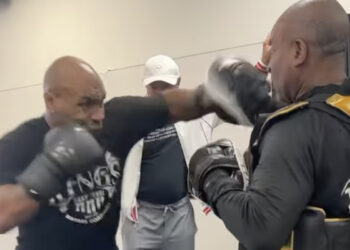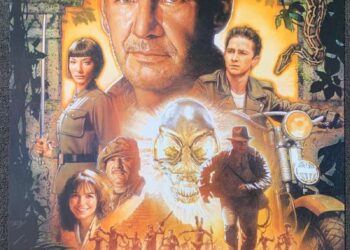In 1982, the world was introduced to one of the most terrifying films in history – Poltergeist. But aside from its spine-chilling storyline and iconic scenes, a behind-the-scenes controversy has long haunted the film. The 1982 movie Poltergeist used real skeletons as props during a pivotal scene, sparking debate about ethics in filmmaking and leaving fans to wonder if this played a role in the alleged curse surrounding the production. This article explores the chilling details of how and why real human skeletons were used in Poltergeist and examines the broader implications of this decision.
The practice of using real skeletons in Hollywood was not uncommon in the past. However, the use of such props in Poltergeist ignited debates due to the film’s subsequent tragedies, leading some to believe the set was cursed. The revelation left audiences shocked and gave the already eerie film an even more terrifying legacy. This article will delve into the facts behind the skeleton scandal and how this decision impacted the horror film industry, the actors, and the fans who continue to discuss it today.
The Truth Behind The Skeletons In Poltergeist
The 1982 movie Poltergeist is widely regarded as one of the most iconic and terrifying horror films in cinematic history. However, what many viewers may not realize is that one of the most chilling scenes in the film has a disturbing real-life backstory. In a shocking twist, the skeletons seen in the film’s infamous pool scene were not just realistic props – they were real human skeletons.
This revelation has sparked controversy and added a layer of macabre intrigue to the already terrifying film. The reason behind this unsettling choice was purely practical. At the time, producing fake skeletons that looked realistic was expensive and time-consuming. To save money, the filmmakers opted to use real human skeletons, which were cheaper and readily available for purchase from medical supply companies. While this was not an uncommon practice in Hollywood during that era, the decision has haunted the film’s legacy.
The skeletons were featured in a scene where Diane Freeling, played by JoBeth Williams, is trapped in a muddy swimming pool, surrounded by skeletons as her home is being torn apart by supernatural forces. Williams later revealed in interviews that she was unaware the skeletons were real during the filming of this intense scene. It wasn’t until after the film’s release that she and the public learned the truth.
The use of real skeletons in Poltergeist has also been linked to the infamous Poltergeist curse, a series of tragic events that befell several cast members after the film’s release. Most notably, young actress Heather O’Rourke, who played Carol Anne, died at the age of 12 due to complications from a medical condition. Dominique Dunne, who portrayed Dana Freeling, was murdered shortly after the film’s release. These tragedies fueled speculation that the use of real skeletons somehow invoked a supernatural curse on the cast and crew.
While experts have dismissed the idea of a curse, the legacy of Poltergeist continues to be shrouded in mystery and controversy. The decision to use real human remains has left an indelible mark on the film’s reputation, making it one of the most talked-about horror productions in history. Decades later, the truth behind the skeletons in Poltergeist remains one of Hollywood’s most eerie and unforgettable stories.
How Did The Cast React To Real Skeletons?
The use of real skeletons in Poltergeist shocked both the audience and the cast members once the truth came to light. Here’s how the cast reacted to the unsettling revelation, broken down into specific responses:
JoBeth Williams’ Shock and Discomfort: JoBeth Williams, who played Diane Freeling, had one of the most intense scenes involving real skeletons. In the famous pool scene, Williams is seen struggling in water, surrounded by skeletons. During filming, she had no idea that the skeletons were real. When the truth was later revealed, she expressed her shock and discomfort, stating that if she had known, she might have refused to film the scene. Williams was disturbed by the notion that she had unknowingly acted alongside real human remains, adding a new layer of eeriness to her experience on set.
Craig T. Nelson’s Professionalism: Craig T. Nelson, who portrayed Steve Freeling, the father in the film, had a more professional response to the situation. Though not directly involved in scenes with the skeletons, Nelson acknowledged the controversy in later interviews but did not let it overshadow his work on the film. His reaction was more subdued compared to other cast members, focusing on the overall film’s success rather than the prop scandal.
Zelda Rubinstein’s Supernatural Beliefs: Zelda Rubinstein, who played the psychic Tangina Barrons, had a unique perspective due to her strong beliefs in the supernatural. Rubinstein was reportedly disturbed by the use of real skeletons and believed it could have invoked negative energy on set. Given her personal beliefs, Rubinstein felt that the decision to use real human remains was disrespectful, possibly contributing to the rumored Poltergeist curse that plagued the cast.
Dominique Dunne’s Reaction: While Dominique Dunne, who played Dana Freeling, did not speak publicly about the skeletons, her tragic murder shortly after the film’s release added fuel to the Poltergeist curse theory. Dunne’s untimely death became part of the lore surrounding the film, with some attributing the tragedies to the use of real skeletons.
The Crew’s Justification: The crew members who were responsible for acquiring and using the real skeletons defended their actions as a cost-saving measure. Special effects artist Craig Reardon stated that using real skeletons was standard practice in the film industry at the time, as they were more affordable than constructing realistic fake ones. However, this explanation did little to calm the discomfort felt by the actors.
The Poltergeist Curse: Fact Or Fiction?
The Poltergeist Curse is one of Hollywood’s most enduring urban legends. After the release of the 1982 horror classic Poltergeist, a string of tragic events surrounding the film’s cast fueled speculation that the production was cursed. The use of real skeletons in the movie, particularly in the infamous pool scene, is often pointed to as the origin of this supposed curse. But is there any truth to the rumors, or is it merely a coincidence?
1. The Tragic Deaths of Cast Members
The curse theory gained traction after the deaths of two young actors. Dominique Dunne, who played Dana Freeling, was murdered by her ex-boyfriend just months after the movie’s release. Heather O’Rourke, who portrayed the youngest child Carol Anne, died at the age of 12 due to complications from a misdiagnosed medical condition. These back-to-back tragedies were seen as more than just coincidences by some, adding weight to the belief in a curse.
2. On-Set Accidents and Strange Occurrences
In addition to the cast’s untimely deaths, stories of bizarre accidents and strange events on set began to surface. Actor Oliver Robins, who played Robbie Freeling, nearly died when a mechanical clown in a scene malfunctioned, choking him. Zelda Rubinstein, who played the psychic Tangina, also claimed to have had unsettling paranormal experiences during filming. Such stories only fueled the narrative that something supernatural was at play.
3. The Use of Real Skeletons and the Supernatural Connection
Perhaps the most chilling aspect that links the curse to the film is the fact that real human skeletons were used during the production. The decision was made to use real bones in the famous pool scene because they were cheaper than fake ones. Some believe that this decision disrespected the dead and invoked some form of supernatural retaliation, causing the eerie string of misfortunes that followed.
4. Dismissing the Curse as Coincidence
Skeptics argue that the so-called curse is nothing more than a series of tragic coincidences. Many film productions face accidents and hardships, and there is no concrete evidence linking the real skeletons to the deaths of the cast members. Experts in the paranormal and cinema dismiss the idea of a curse, pointing out that the tragedies surrounding Poltergeist are sad but not unusual in Hollywood’s history.
While the Poltergeist curse makes for a compelling story, there is no concrete evidence to suggest that supernatural forces were at play. The real-life tragedies and accidents are heartbreaking but likely coincidental. The eerie nature of the film, combined with the use of real skeletons and the tragic deaths, simply created the perfect storm for a long-lasting urban legend. Whether you believe in the curse or not, the legacy of Poltergeist remains one of the most unsettling in film history.
The Final Words
the 1982 movie Poltergeist has left an unforgettable mark on cinematic history, not just for its terrifying plot but for the disturbing revelation that real skeletons were used as props. This controversial decision has fueled rumors of a curse that surrounded the film’s cast, with tragic events only adding to the eerie lore. Whether you believe in the supernatural or chalk it up to coincidence, the use of real skeletons remains one of Hollywood’s most unsettling stories, forever linking Poltergeist with both horror on-screen and behind the scenes.
FAQ
What is the Poltergeist curse?
The Poltergeist curse refers to a series of tragic events that affected the cast, including several untimely deaths. Some believe these events were connected to the use of real skeletons on set.
Are real skeletons still used in films today?
No, the practice of using real human remains has largely been abandoned due to ethical concerns.
Did the use of real skeletons affect the film’s reception?
While it didn’t affect the initial reception, the revelation added a new layer of controversy and intrigue to the film’s legacy.







